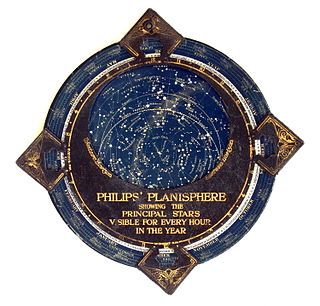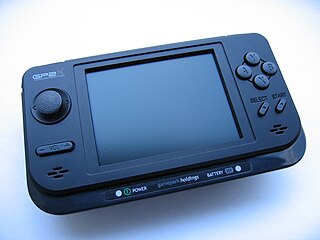
Amateur astronomy is a hobby where participants enjoy observing or imaging celestial objects in the sky using the unaided eye, binoculars, or telescopes. Even though scientific research may not be their primary goal, some amateur astronomers make contributions in doing citizen science, such as by monitoring variable stars, double stars, sunspots, or occultations of stars by the Moon or asteroids, or by discovering transient astronomical events, such as comets, galactic novae or supernovae in other galaxies.

The GP32 is a handheld game console developed by the South Korean company Game Park. It was released on November 23, 2001, in South Korea and distributed in some parts of Europe.

In astronomy, a planisphere is a star chart analog computing instrument in the form of two adjustable disks that rotate on a common pivot. It can be adjusted to display the visible stars for any time and date. It is an instrument to assist in learning how to recognize stars and constellations. The astrolabe, an instrument that has its origins in Hellenistic astronomy, is a predecessor of the modern planisphere. The term planisphere contrasts with armillary sphere, where the celestial sphere is represented by a three-dimensional framework of rings.

A finderscope is an accessory sighting device used in astronomy and stargazing, typically a small auxiliary refracting telescope/monocular mounted parallelly on a larger astronomical telescope along the same line of sight. The finderscope usually has a much smaller magnification than the main telescope, thus providing a larger field of view, useful for manually pointing the main telescope into a roughly correct direction that can easily place a desired astronomical object in view when zooming in. Some finderscopes have sophisticated reticles to more accurately aim the main telescope and/or even perform stadiometric measurements.

The Canon EOS 5 is a semi-professional autofocus, autoexposure 35 mm SLR film camera. It was sold from November 1992 onwards, and was replaced in late 1998 by the Canon EOS 3. As part of the EOS line of cameras, the 5/A2/A2e utilized Canon's EF bayonet lens mount, first introduced in 1987.

The GP2X is a Linux-based handheld video game console and portable media player developed by South Korean company GamePark Holdings. It was released on November 10, 2005, in South Korea only.
mySky was a personal astronomy tool made by Meade Instruments. When pointed at an area of sky, it was supposed to identify objects based on its built-in database of 30000 objects. It also claimed it could guide the user to a particular object from its database. It has an LCD display, unsuccessfully incorporates GPS technology and can not be linked to a compatible Meade computer-controllable telescope. Note, however, that mySky is not a telescope or observing instrument.

In amateur astronomy, "GoTo" refers to a type of telescope mount and related software that can automatically point a telescope at astronomical objects that the user selects. Both axes of a GoTo mount are driven by a motor and controlled by a computer. It may be either a microprocessor-based integrated controller or an external personal computer. This differs from the single-axis semi-automated tracking of a traditional clock-drive equatorial mount.

The Nikon D300 is a 12.3-megapixel semi-professional DX format digital single-lens reflex camera that Nikon Corporation announced on 23 August 2007 along with the Nikon D3 FX format camera. The D300 was discontinued by Nikon on September 11, 2009, being replaced by the modified Nikon D300S, which was released July 30, 2009. The D300S remained the premier Nikon DX camera until the D7100 was released in early 2013.

The Nikon D90 is a 12.3 megapixel digital single-lens reflex camera (DSLR) model announced by Nikon on August 27, 2008. It is a prosumer model that replaces the Nikon D80, fitting between the company's entry-level and professional DSLR models. It has a Nikon DX format crop sensor.

The Panasonic Lumix DMC-GH1 is a digital mirrorless interchangeable lens camera adhering to the Olympus and Panasonic developed Micro Four Thirds System (MFT) system design standard. Panasonic classified the GH1 as a hybrid stills/video camera and the GH1 was introduced and marketed as a higher end camera than Panasonic's first MFT camera, the stills only, non-video capable Lumix DMC-G1.

The Dingoo is a handheld gaming console that supports music and video playback and open game development. The system features an on-board radio and recording program. It is available to consumers in three colors: white, black, and pink. It was released in February 2009 and has since sold over 1 million units.

The Canon EOS 7D is an APS-C digital single-lens reflex camera made by Canon. It was announced on 1 September 2009 with a suggested retail price of US$1,699. Among its features are an 18.0 effective megapixel CMOS sensor, HD video recording, its 8.0 frames per second continuous shooting, new viewfinder which offers 1.0X magnification and 100% coverage, 19-point auto-focus system, movie mode, and built-in Speedlite transmitter.

The Nikon Coolpix L100 is a semi-compact digital camera produced by Nikon Corporation and is part of the Nikon Coolpix series. It belongs to the "Life" series of Nikon digital cameras, which are intended for beginner and amateur users, announced in 2009.

The Canon EOS-1D X is a professional digital SLR camera body by Canon Inc. It succeeded the company's previous flagship Canon EOS-1Ds Mark III and the Canon EOS-1D Mark IV. It was announced on 18 October 2011.

The Sony α77 was the flagship for Sony's midrange Alpha SLT camera line.

The Canon EOS 6D is a 20.2-megapixel full-frame CMOS digital single-lens reflex camera made by Canon.

Announced by Sony on August 24, 2011, and launched alongside its brother the Sony Alpha 77, the Sony Alpha 65 is the top-tier for Sony's midrange Alpha SLT camera line.

The Nikon D5600 is a 24.2 megapixel upper-entry level, APS-C sensor DSLR announced by Nikon on November 10, 2016 The successor of the D5500. The camera has an F-mount.

The Canon EOS R is a 30.3 megapixel full-frame mirrorless interchangeable-lens camera launched by Canon in October 2018.



















